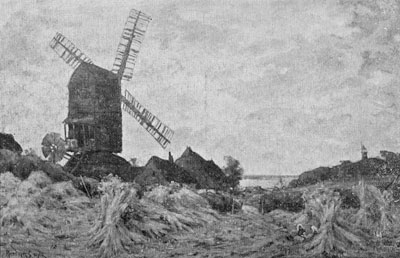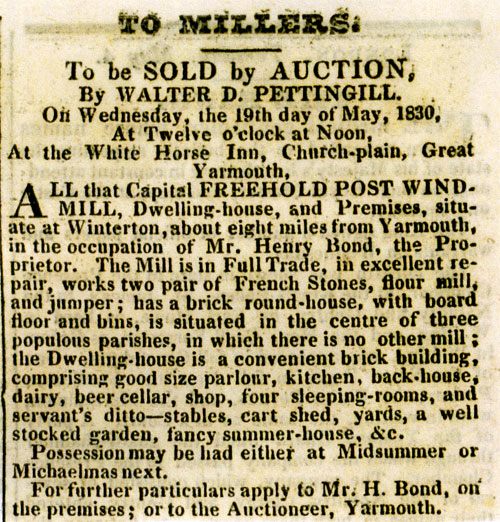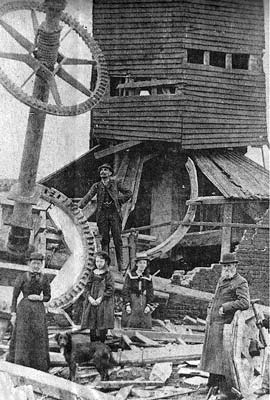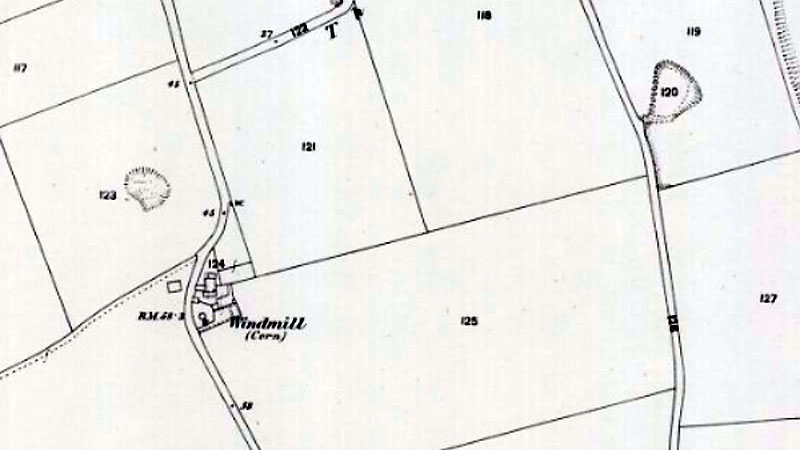
Winterton postmill |
 |
Painting by Montague-Smyth c.1900 |
Winterton post windmill stood at Mill Farm on the east side of the Hemsby Road to the southwest of the village and was probably erected in 1700 as that date was carved into the centre post. It ran for over 200 years before being wrecked by a violent storm in 1902. The mill had a brick roundhouse and was turned to wind by a 6 bladed fantail set on the ladder leading up to a leanto porch. Four double shuttered sails, each with 8 bays of 3 shutters drove two pairs of French burr stones set 'head & tail', a flour mill and jumper. |
Robert Davy had moved from Hemsby_towermill where he had been recorded in the 1841 census |
To be SOLD by PRIVATE CONTRACT With Immediate Possession |
 |
Norfolk Chronicle - 8th & 15th may 1830 |
WINTERTON
To be Sold by Auction by Pettingill at Dukes Head, Great Yarmouth, Wednesday 12 July 1843 at 6 o'c |
To be sold or let |
Gale unroofs Winterton Mill |
DEATH OF A MILL by A. A. C. Hedges |
YARMOUTH FAIR is notorious for the bad weather it brings with it. Year after year it is accompanied by drenching rain or by a howling north-easter which freezes the very marrow in the bones. Nowhere, however, is that first weekend after Easter anticipated with quite so much trepidation as in the village of Winterton. In that bleak and exposed spot on the East Coast, with very little land between them and the North Pole, villagers have long memories and the calamity that befell them on that same weekend in 1902 is deeply ingrained in the public consciousness. That was the night the mill was destroyed in a matter of minutes. Nobody knows how old the mill was, but the date 1700 was carved on her post and she was a familiar sight to generations of Flegg dwellers. She was a very large mill as mills go, and was situated on the rising ground just outside the village of Winterton to the left of the S bend on the rend to Hemsby. Tradition has it that her sails were so big that they swung over the heads of passers-by in the road below and so frightening was their groaning and creaking that even the most experienced of carters had difficulty in persuading their horses to pass beneath them. |
Horse and cart |
In 1902 the mill was owned by the Starling family – the old miller being known as “Kruger” to every man, woman and child for miles around. He and his son Austick ran the mill on sound commercial lines. Business was satisfactory. Not only did the family grind the grain brought in by neighbouring farmers, but Austick sold flour for breadmaking and corn for chicken feed from a horse and cart in the nearby villages. But as the years passed, more and more of the day-to-day management of the business was left to Austick and his father, now a widower, built a house for himself on the opposite side of the road and submitted himself to the care of his daughter, Georgina. The day of the tragedy dawned, most unusually for a fair weekend, with no threat of danger. The sun shone out of a clear blue sky and there was just a breath of wind. There was little work on hand and Austick, who had business to attend to in Repps, had no hesitation in leaving the mill in charge of other members of the family. He was, however, careful to give specific instructions as to what was to be done in his absence. He told them to grind a certain quantity of corn and then shut the mill down by fastening the sails facing to the south-west. This was in fact their normal practice. All this they did and the daylight hours passed uneventfully and Austick returned home well satisfied with the results of their labours. |
First warning |
That same night an eerie and all pervasive noise was heard far out to sea. It puzzled even the coastguards on watch and it did not occur to anyone that it was caused by the rising wind. Yet that was the first warning the villagers had that anything was amiss and that they were about to experience on of the severest storms in the history of the village of Winterton. In seconds it was blowing a gale from the north-east and the landscape was lashed with torrential rain. Austick, like most of the village, was awakened from his sleep, and realising the danger that threatened the mill, rushed downstairs, dressing as he went, with the intention of releasing the ties preventing the fan wheel from operating and the sails from turning. Despite his haste he was too late. The old mill could not withstand the fury of the storm even for that brief space of time and the entire structure came crashing to the ground. Miraculously, no one was hurt but Austick had a lucky escape. Had he not been delayed for a few seconds by the pitch blackness of the night and run unseeing into an apple tree, he would almost certainly have been killed or at least badly injured. As it happened all he had to show for his night’s adventure were a few scratches on the cheek caused by the apple tree, but his beloved mill was a complete ruin – a heap of timber and twisted machinery, with very little of the original fabric still standing. The sails of Winterton mill would never turn again. |
Nondescript |
All that remains nowadays to remind one of that night of tragedy is a dwelling known as Mill House and a small building of nondescript appearance, with the chimney breast covered with ivy, which once stood adjacent to the old mill but escaped without a scratch. That was destined to become Winterton’s earliest ladies’ hairdressing salon and it was owned by Mrs. Annie Ives, one of Mr. Starling’s married daughters. Even so, despite this paucity of architectural remains, the bend on the road to Hemsby is known locally as Mill Corner to this very day and every man jack of in Winterton are relieved when the showmen have moved on and Yarmouth Market puts on its familiar face once again. |
 |
1902 |
The old post-mill in this parish has succumbed to the dreadful hurricane. She was the last of this class in the Fleggs. The accident was caused by her being tail to wind when the gale suddenly burst and consequently she ran backwards and was blown out of the house. She has been for years past an object of much interest to artists, visitors and others being so near the public highway and has weathered the storm for close on two centuries. The damage was about £200. |
HEAVY GALE |
After the mill was destroyed in the gale of 1902, the owner, Kruger Austic Starling, used a steam engine to power a mill in a nearby barn for some years. |
 |
O. S. Map 1884 Courtesy of NLS map images |
White's 1890: George Davey Starling, farmer |
c.1700: Mill built
1843: Edward Palmer, miller July 1843: Mill advertised for sale by auction White's 1845: Edmund Palmer, corn miller 1846: Robert Davey, miller
1853: Robert Davey, miller White's 1854: Robert Davey, corn miller 1856: Robert Davey, miller October 1857: Mill advertised for sale or let
1863: George Starling, miller White's 1864: George Starling, corn miller 1865: George Starling, miller 1868: George Starling, miller
1872: George Starling, miller 1878: George Davey Starling, miller
White's 1883: George Davey Starling, miller, farmer and owner, and assistant overseer and tax collector O.S. map 1884: Windmill (Corn) 1888: George Davey Starling, miller White's 1890: Austie Wallace Starling, corn miller & assessor of taxes
Kelly's 1896: Austic Wallace Starling, miller (wind) Kelly's 1896: George Davey Starling, miller (wind) & farmer Kelly's 1896: Austic Wallace Starling, miller (wind)
Kelly's 1900: Austic Wallace Starling, miller (wind)
7th April 1902: Mill destroyed by a violent storm |
If you have any memories, anecdotes or photos please let us know and we may be able to use them to update the site. By all means telephone 07836 675369 or
|
| Nat Grid Ref TG 492188 |
Copyright © Jonathan Neville 2004 |